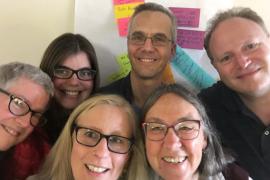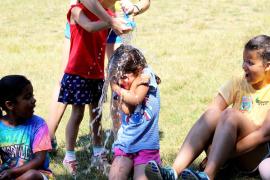Hello again! I’m back with a follow-up post about demographics and evaluation at camp. Hopefully, many of you had a chance to read my last post where I started to discuss why the way we think about and measure our campers’ demographic information matters. Here are some of the main points:
- Collecting demographic information can be a useful way to identify trends of who is coming to camp and when; it may also help us better understand who isn’t coming to camp.
- Put intention into how you word questions that ask for demographic information. Your word choices wield power and have the possibility to overlook specific identities.
- Be aware of the limitations that exist when comparing outcomes based on demographic data. Doing so may help you identify differences; however, they do not necessarily point to why they exist.
- People experience life at the intersection of their identities, not as each identity individually. Using just one demographic variable to compare data can overlook campers’ unique experiences and probably don’t tell the whole story.
Many of us have heard that in the not-so-far-off future (2044), the US populace will no longer be majority White. When this happens, the US will become a majority-minority country, which means that there will no longer be one racial/ethnic group that is the numerical majority. In many ways, this shift has already occurred when we look at the fact there are more babies being born of racial-ethnic minorities than there are non-Hispanic White babies being born each year. Recent projections have shown that by 2020 the under-18 population will no longer be a majority White.
As of a recent 2018 ACA report, a majority of youth who attend camps identify as non-Hispanic White. However, given the continued changes in demographics, it is likely that many campers live in communities with much greater diversity than many summer camps. It may also mean that as a field, organized camping does not serve a representative population of youth. So, what does all this have to do with demographic information and evaluation? Quite a bit, actually. As you may recall, a major point of my previous post was focused on using demographic information as a way to create more equitable camp experiences. There are two primary ways this might happen: 1) demographic data can help highlight trends in participation, and 2) demographic data may point to differences in certain outcomes.
After reading number 2, you may be wondering, “I thought using demographic information as a way to compare outcomes wasn’t necessarily a good practice” – the answer is that it’s more complicated than a simple “it’s good” or “it’s bad” answer. Try thinking about results that show differences as the title of a book. While the title can often help you get a sense of what the story might be about, until you open it up and really dive in, you’re left with a lot of questions. While I do not necessarily want to equate different identities with book titles, I think the metaphor can help further unpack how demographic data can help us create more equitable experiences. Before reading on, please note that the example I provide is fictitious; however, it could very well exist. Second, the story is not meant to reinforce stereotypes about certain groups. However, the example does consider historically and contemporarily oppressed groups and those most likely to experiences inequities when it comes to camp.
Let’s say that I am the director of a camp that is about 30 minutes from a relatively large city. The greater metro area is quite diverse, with a mix of families, single, and old and young residents. In addition, the metro area is racially and ethnically diverse, with a large immigrant population, and various ethnic communities that are well-established in different neighborhoods throughout the city. There is also a wide distribution of wealth, with a large number of families from low and lower-middle-income households.
At the end of the summer when looking at my camper evaluations, I noticed that the demographic data of my camp does not necessarily match the metro area where many of the campers who attend my camp live. However, among my demographic information I notice that about 35 percent of my campers received some sort of financial scholarship to attend. While proud of my ability to provide this resource to families who might not otherwise be able to afford the cost of camp, I also notice that these campers reported lower levels of camp connectedness than students who did not receive a scholarship. As I think about these results, I begin to formulate my next steps.
My first step is to pass this information along to the rest of my team. This is an important matter that we must investigate. Second, I begin to poke around the data a bit more. What happens when I add another demographic variable to the comparison — let’s say gender. The results of this next step suggest that campers who received scholarships and identified as boys reported lower scores than campers who identified as girls. A-ha — I’m on to something! I then add one more demographic variable to the comparison — race/ethnicity. It turns out that boys who received scholarships and were from the predominant immigrant population in the nearby city reported the lowest camp connectedness scores. With this information in hand, I can begin to consider what aspects of camp, especially related to programming and staffing, might be a contributing reason as to why campers who fit that description might feel less connected to camp. As part of this process, I must not only reflect from my own point of view but also do my research to better understand the many cultural norms that might be at play that affect campers’ experiences. While this may not be an easy, or straight-forward process, it is a necessary step to creating more equitable experiences.
If you’d like to learn more from experts about the most equitable ways to address the potential concerns with collecting and measuring demographic information, check out the following videos:
- Conceptualizing and Measuring Culture, Context, Race, and Ethnicity — Introduction
- Best Practices in the Measurement and Conceptualization of Race and Ethnicity: A Guided Discussion
- Influence of Contextual Factors and Individual Differences: A Guided Discussion
Photo courtesy of Camp John Marc in Meridian, Texas
Rob Warner, a research assistant for ACA, is a doctoral student at the University of Utah and has worked in the youth development field for a variety of organizations as a counselor, field instructor, and mentor.
Thanks to our research partner, Redwoods.
Additional thanks goes to our research supporter, Chaco.
The views and opinions expressed by contributors are their own and do not necessarily reflect the views of the American Camp Association or ACA employees.





